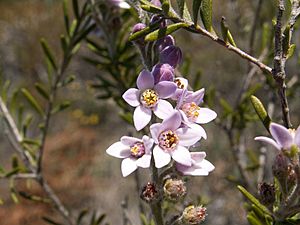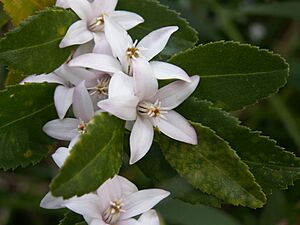Crowea angustifolia facts for kids
Quick facts for kids Crowea angustifolia |
|
|---|---|
 |
|
| Crowea angustifolia var. platyphylla | |
| Scientific classification | |
| Genus: |
Crowea
|
| Species: |
angustifolia
|
Crowea angustifolia is a beautiful flowering plant. It belongs to the plant family called Rutaceae. This plant only grows naturally in the south-west part of Western Australia. It's a tall shrub that can grow up to 3 meters (about 10 feet) high and 1 meter (about 3 feet) wide. In spring, it shows off lovely white or pink flowers.
What Does Crowea angustifolia Look Like?
Crowea angustifolia is a shrub that can be different sizes. It can grow from 0.3 meters (about 1 foot) to 3.5 meters (about 11 feet) tall. Some plants grow straight up, while others spread out more.
Its leaves are thin and smooth (this means they are glabrous). They can be long and narrow, or wider and egg-shaped. The leaves are usually between 50 and 80 millimeters (about 2 to 3 inches) long. They are less than 15 millimeters (about half an inch) wide.
The flowers usually grow one by one where the leaves meet the stem (this is called the axil). Each flower sits on a small stalk called a pedicel, which is 2 to 5 millimeters long. At the base of each flower, there are two to four small leaf-like parts called bracteoles.
Each flower has five separate, papery parts called sepals, which are round and about 2 millimeters long. It also has five white or pink petals that are egg-shaped, thin, and about 12 millimeters long. Inside the flower, there are ten stamens (the parts that make pollen) and a style (part of the female reproductive organ). Both are about 7 millimeters long. You can see these flowers from September to December.
How Was Crowea angustifolia Named?
The plant Crowea angustifolia was first officially described by a scientist named James Edward Smith in 1808. He studied a plant sample collected by "Mr Menzies" near King George's Sound.
The second part of its name, angustifolia, comes from two Latin words. Angustus means "narrow," and folium means "leaf." So, the name describes its narrow leaves.
Scientists recognize two main types, or varieties, of Crowea angustifolia:
- C. angustifolia var. angustifolia: This type usually has more linear (straight and narrow) leaves and often pink flowers.
- C. angustifolia var. platyphylla: This type has wider, more egg-shaped leaves and usually white flowers.
A scientist named Paul Graham Wilson first named the second variety dentata, but he later changed it to platyphylla.
Where Does Crowea angustifolia Grow?
This plant only grows naturally in the very south-western part of Western Australia. You can find it in areas like the Jarrah Forest, Swan Coastal Plain, and Warren regions. It likes to grow in sandy soils, gravel, or on granite rocks. You might see it on ridge tops, slopes, and rocky outcrops.


